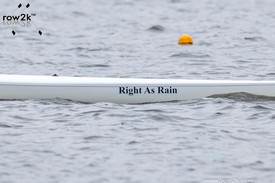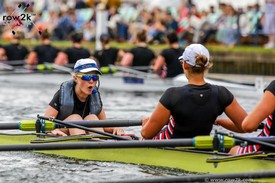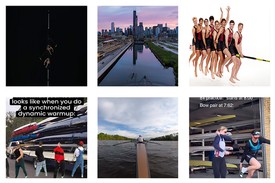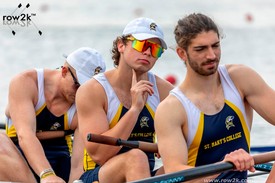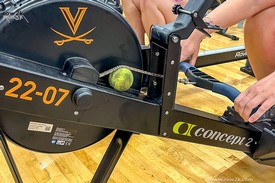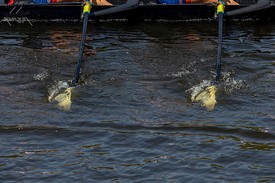In the Driver's Seat, with Nina Castagna
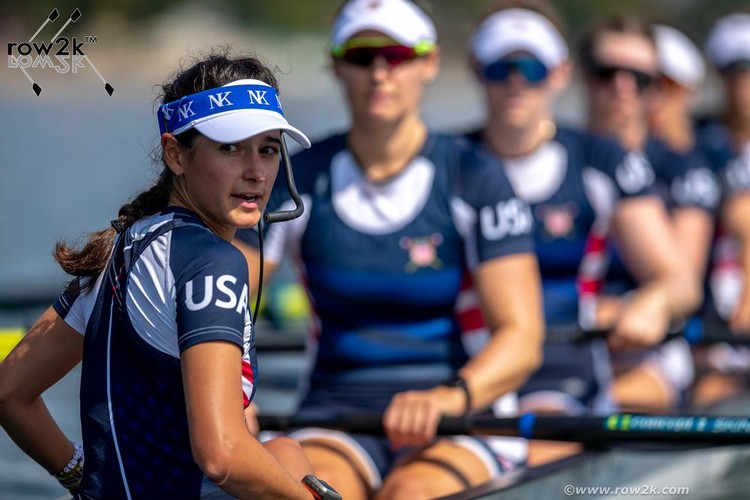
Next up In The Driver's Seat--where we hear from the folks who keep the shells straight and the crews fast—-is coxswain Nina Castagna.
Nina made the most of her debut with the US National Team this past summer, coxing the women's eight to pretty thrilling come-from-behind silver medal in the final sprint.
Before moving up to the international stage, Nina coxed the varsity eight at the University of Washington, racing with the Huskies 1V in three consecutive NCAA Championship A Finals, and she got her start in high school with the Cincinnati Juniors.
Since Nina recently made the jump from college to the national team after graduating from Washington, we asked her a bonus question about the biggest difference she's noticed, so far.
Let's hop In The Driver's Seat with Nina:
row2k - What do you see as the three most important things for being a successful coxswain?
Nina Castagna - It’s hard to boil the job down to just three keys for success, but these are the ones that I’ve found have helped me the most in my personal experience: trust, communication, and steering.

Trust has always been the most important thing for me in being a successful coxswain. It’s incredibly important that your athletes and coaches trust you and your judgment, because at the end of the day, your decisions and voice are what the crew will rally behind. It’s equally important to have the same level of trust in your athletes. I never want to ask my crew to do something that I don’t believe we’re capable of, so it’s important that I build a level of trust that I can rely on come race day. I believe that real trust can only be earned over time, which is one of the reasons it’s the most valuable trait that comes to mind.
Communication skills are another obvious but essential trait of a good coxswain. The ability to coherently explain concepts on the water, work well with coaches, and manage athletes off the water are all crucial to the success of a team.
I think one of the most commonly overlooked traits of a successful coxswain is steering. It’s not always quite as glorious as some of the other skills, but to me being good at it is a mandatory part of the job. Whether you’re hugging the turns of a river, steering down a buoy line, or following a point 3,000 meters away, your understanding of the rudder can make a big difference in the success of your boat. Beyond the addition of meters from a bad line, any more movement of the rudder than necessary can throw the boat off balance and disrupt drilling, rhythm, and racing in the process.

row2k - What is your favorite drill to run with your crews? Any tips on how to the drill well, for maximum effectiveness?
Nina Castagna - I’ve always loved the reverse pick drill, which consists of building the stroke out from the front end (rowing top quarter, legs, legs body, and then full). I think it’s versatile enough to be run with a variety of focuses and can help in virtually any situation. There are great opportunities to work the placement, top quarter connection, suspension, proper initial push, hip extension, and many other facets of the stroke during this drill.
As with any drill though, it will be most effective if you pick just one focus and keep it simple. Too much feedback about differing points of the stroke will hurt more than it will help. If you’re going to work top quarter connection during the drill, then give the group a few cues as to what they should be feeling and give them the space to work it out. If you see or feel progress, definitely validate it! Then as you add in more of the stroke, see if you all can maintain the feeling you just created.

row2k - What's some of the best coaching advice you've received about your coxing?
Nina Castagna - That you don’t always need to make the perfect call during the race: races are won during the preparation.
For most of my collegiate career, I had the impression that there was some special call that I’d have to make during the race that would be the reason we won, and if I didn’t, I’d be the reason we lost. The reality is that I had a much greater chance of helping us win during practice than I ever did during an actual race. In virtually every session leading up to race day, I’d make references to our race plan, practice racing scenarios, and unify the mentality of our group so that on race day, the only calls I really needed to make were ones to help us execute our plan. Once I took the pressure of a perfect call off of myself, I was finally able to race freely.

row2k - What is a mid-race call or move that you've made that you'll remember for the rest of your life?
Nina Castagna - I’ll probably remember the 1200m mark from the 2023 World Championship for the rest of my life. We’d just crossed into the back thousand sitting in last place, within a seat of GB, Canada, and Italy for bronze. At that point, I remember feeling confident that our last 750 was strong enough to win that four way tie and make the podium, so that was my only goal. As we entered the last 800 though, I saw Australia, who led the race to this point, fall back about a seat on the field. Although they were still up a length on us, that slip was all I needed to know that they were potentially catchable and I almost immediately shifted my attention towards a race for gold.
You can watch that last 800 meters--and the full race--in this video from the A Final at the Belgrade World Championships.
I’ll remember that moment forever because of the sense of mutual trust in the boat. In a situation where we could have been focused on simply qualifying for the Olympics or just racing for bronze, I trusted that we were capable of more and made the call to move through the field towards the top of the podium.
It was an extremely decisive call, that we were going to go catch Australia, and I’m sure if I’d waited even five more strokes to call for it, we would’ve run out of room in the end. I think it was a pretty great showcase of their trust in me too, to move past the margins for fourth, fifth, and sixth, and know that if I was calling for a push to second, then we could do it.

row2k - Can you tell us anything about how you learned how to call the sprint?
Nina Castagna - Simplicity is the top priority. It’s much harder for your athletes to digest information as you approach the end of a race and fatigue sets in, so the simpler the calls, the better. A good sprint call can be as simple as communicating margins and distance.
I make sure that everyone knows where we stand on the field, how many seats we are out of our goal position, and how much time we have left to achieve our goal. This is especially valuable in tight racing scenarios where you’re a few seats out of the lead or a medal position and only have a couple hundred meters to close the gap. I’ll also feel for any technical aspect (sitting taller, compression, top inch, etc.) that can give us speed and repeat the call for a good few strokes until I’ve felt a positive change in speed.
Along with simplicity, it’s important to stay calm in the sprint. As much as every coxswain (myself included) feels the urge to get loud and scream their way to the line, tone of voice can impact the stroke heavily. Too much yelling can create tension in the bodies that will hinder speed instead of building it.

row2k - Tell us a bit about your worst race/practice?
Nina Castagna - My goal every time I get in a boat is to try to make it faster than it was when I first got in. As a result, there aren’t really any good or bad sessions in my mind, just different experiences. Of course, I’ve had my fair share of sessions that didn’t quite go my way, but I’ve found that as long as I can take something away from the experience then it was worth it in the end.
row2k - How about your best race or practice?
Nina Castagna - One of my favorite parts of being in the driver’s seat is driving--so it's no surprise that most of my favorite practice memories specifically involve steering. In high school, I used to steer a river where getting the inside turn during a piece felt like life or death. I learned how to put the tips of our oars just inches off the shore and squeeze my bowball into dangerously tight spots; risky maneuvering that I’ve since avoided but will always remember fondly.
At the University of Washington, I learned to steer much straighter using distant points on shore, all while still maintaining my love for taking a good turn. The unit of coxswains at UW would pride ourselves in our ability to run a fleet of boats as if they were tied together, and our coach would call us "The Purple Angels" in reference to the famous Blue Angels fighter pilots. The practices where we’d float a 90 degree turn four boats wide are the ones that I’ll really never forget.

row2k - What's the biggest difference between practicing with the National Team compared to going out with a college crew?
Nina Castagna - I’ll say that the biggest difference so far has been the timeline between arriving at the training center and racing with the team. In collegiate rowing, this period was over eight months whereas it was only about two and a half this summer. Eight months was a lot of time to get to know my teammates, develop trust, and train alongside one another--all of which helped us to feel ready when spring racing came along.
It was definitely a bit of an adjustment to get the same effect in ten weeks, but I realized pretty quickly that it just meant we needed to be extremely intentional with our time. By the time the lineup was set, we were already geared towards how we wanted to execute our race in Belgrade and how each stroke we took in the meantime would prepare us for it.
Thanks for riding along with Nina, and remember, this column is open to all "drivers" out there, so if you are an experienced coxswain at any level--from juniors to masters--and would be willing to invite row2k to join you in your ride, just contact us here. We’d love to hear from you about what you see from the Driver's Seat.

If you enjoy and rely on row2k, we need your help to be able to keep doing all this. Though row2k sometimes looks like a big, outside-funded operation, it mainly runs on enthusiasm and grit. Help us keep it coming, thank you! Learn more.
Comments | Log in to comment |
There are no Comments yet
| |
- Bont Rowing
- Calm Waters Rowing
- Concept 2
- Craftsbury Sculling
- The Crew Classic
- CrewLAB
- Croker
- Dad Vail Regatta
- Durham Boat Co.
- Empacher
- Faster Masters
- Filippi
- Fluidesign
- h2row.net
- HUDSON
- myrow
- Nielsen-Kellerman
- Oak Ridge RA
- Peinert Boat Works
- Pocock Racing Shells
- Race1 USA
- Rockland Rowing Masters Regatta
- RowKraft
- Rubini Jewelers
- Vespoli USA
- WinTech Racing
- Bont Rowing
- Calm Waters Rowing
- Concept 2
- Craftsbury Sculling
- The Crew Classic
- CrewLAB
- Croker
- Dad Vail Regatta
- Durham Boat Co.
- Empacher
- Faster Masters
- Filippi
- Fluidesign
- h2row.net
- HUDSON
- myrow
- Nielsen-Kellerman
- Oak Ridge RA
- Peinert Boat Works
- Pocock Racing Shells
- Race1 USA
- Rockland Rowing Masters Regatta
- RowKraft
- Rubini Jewelers
- Vespoli USA
- WinTech Racing



